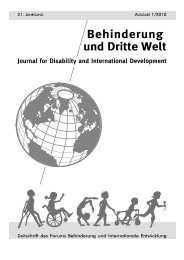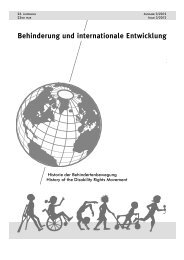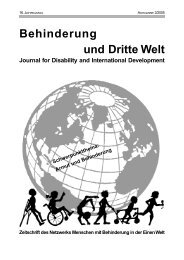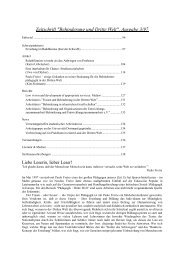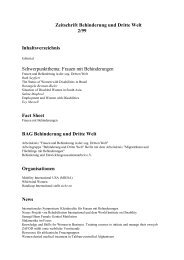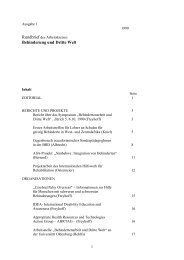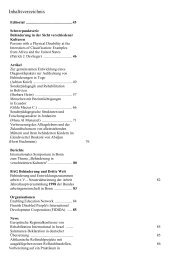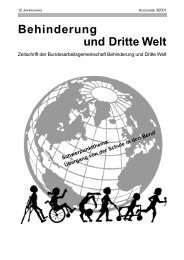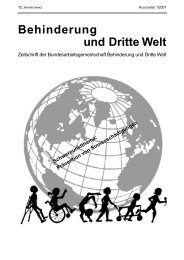S CHWERPUNKTTHEMAEnsuring Inclusion of Women withDisabilities in Gender and DisabilityPoliciesAs new disability policies and improved genderpolicies are rolled out across the Asia-Pacific region,an important question to ask upfront is:How and where do gender and disability policiesintersect? How will gender policies effectivelyincorporate the needs, experiences andviews of women with disabilities? How will disabilitypolicies mainstream women with disabilities,and effectively incorporate issues thatare a specific priority for women with disabilities?Development of joint frameworks that acknowledgethe links between gender and disabilityis one step in the right direction. Delineatingpolicy objectives and outcomes specificallyfor women with disabilities is another. In practicalterms, this may mean empowering womenwith disabilities to be engaged in gender and indisability policy development and in the monitoringof policy roll out.Some questions policy developers can askthemselves are:- Is mainstreaming an effective strategy for includingwomen with disabilities in genderand disability policy?- Are there additional strategies that can bedeployed alongside mainstreaming focusingspecifically on women with disability?- Have lessons from gender mainstreaming inother sectors been adequately absorbed sothat the similar oversights are avoided in disabilitypolicy?- Is it enough for disability policies to pledge acommitment to equal participation, contributionand benefit for men and women withdisabilities when women with disabilities experiencemarginalization and exclusion in diverseand different ways to men?The approach to disability has been steadilyshifting from a welfare model to a rights-basedand empowerment one, and this has been apparentin the increasing deployment of inclusiveand participatory policy development methodologies.For example, AusAID went about formulatingand articulating its disability policy byconsulting organizations of people with disabilitiesin the Asia-Pacific region. The result is astrategy <strong>und</strong>erpinned by a commitment to theattainment of human rights rather than a focuson service delivery.Similarly, policies in both the gender anddisability sectors can do more to ensure womenwith disabilities have a voice in its development.This could include:- Engaging women with disabilities in dialogueand decision-making in both the areasof gender and disability policy prioritization.- Collecting adequate disaggregated data onwomen with disabilities and building localcapacity to do this effectively, so that policy isinformed by evidence.- Focusing on the financial, attitudinal andphysical barriers that prevent equal access(bearing in mind that women with disabilitiesface different obstacles to women withoutdisabilities and men).- Strengthening the leadership of organizationsspecifically representing the experiencesand interests of women with disabilities.- Increasing the capacity of women with disabilitiesto represent themselves in both disabilityand gender interest groups.- Create mechanisms for accountability inboth sectors and including women with disabilitiesin all aspects of this process.- Developing a specific policy addressing thekey concerns of women with disabilities, andensuring these are well integrated into bothdisability and gender policies.Moving ForwardA review of the literature suggests that womenwith disabilities are not being effectively includedin gender policies. Their specific concernsmay not also be adequately addressedwith disability policies alone. Ensuring that theinteraction between gender and disability isconsidered in policy development may be oneway of providing equity for women with disabilities.Another is by including women withdisabilities in gender policies. In addition, genderand disability silos could be broken downby articulating unique policies addressing thekey concerns of women with disabilities. Thisarticle puts forwards some issues for policy developersto consider with regard to more effectiveinclusion. However, by far, the most importantmeans of ensuring women with disabilitiesare being included is by ensuring they play acentral role in both the process and the outcomeof all gender and disability policies.32 <strong>Zeitschrift</strong> <strong>Behinderung</strong> <strong>und</strong> <strong>Dritte</strong> <strong>Welt</strong> 3/2009
S CHWERPUNKTTHEMAReferencesALBERT, B./MILLER, C. (2006): Mainstreaming disability indevelopment cooperation: lessons from gender mainstreaming.In or out of the mainstream? Lessons fromresearch on disability and development cooperation.The Disability Press. LeedsAUSAID (2007): Gender equality in Australia’s aid program– why and how. AusAID. CanberraAUSAID (2008): Gender equality: Annual thematic performancereport 2006 – 2007. AusAID. CanberraAUSAID (2008): Development for all: Towards a disability-inclusiveAustralian aid program 2009 – 2014. AusAID.CanberraCBM (2007): CBM Disability and Development Policy.CBM. BensheimDERBYSHIRE (2002): Gender Manual: A practical guidefor development policy makers and practitioners. SocialDevelopment Division, DFID. LondonDFID (2000): Disability, Poverty and Development. DFID.LondonEDMONDS, L.J. (2005): Disabled People and Development.Poverty and Social Development Papers. No. 12/ 2005. ADB. ManilaFIDUCCIA, B.W./Wolfe, L.R. (1999): Women and girls withdisabilities: defining the issues. Center for WomenPolicy Studies and Women & Philanthropy. WashingtonMOHAPATRA, S./MOHANTY, M. (2004): Abuse and activitylimitation: A study on domestic violence against disabledwomen in Orissa, India. Swabhiman. OrissaRAO, I. (2005): Equity to women with disabilities in India.CBR Network. BangaloreRAO, A./KELLEHER, D. (2005): Is there life after gendermainstreaming? Gender and Development. 13 (2), 57– 69SANDS, T. (2005): A voice of our own: advocacy by womenwith disability in Australia and the Pacific. Genderand Development. 13 (3), 51 -62THOMAS, M./THOMAS, M.J. (2003): Addressing concernsof women with disabilities in CBR. Paper presented atUNESCAP Workshop on Women and Disability. BangkokUNESCAP (1995): Hidden Sisters: Women with Disabilitiesin the Asia Pacific Region. Social Development DivisionUNFPA (2003): Maternal mortality update 2002: A focuson emergency obstetric care. UNFPA. New YorkUNITED NATIONS MILLENIUM PROJECT TAST FORCE ONEDUCATION AND GENDER EQUALITY (2005): TakingAction: Achieving gender equality and empoweringwomen. Earthscan. LondonZusammenfassung: Frauen mit <strong>Behinderung</strong> gehören zuden ärmsten <strong>und</strong> ausgegrenztesten Mitgliedern der Gesellschaft.Eine Überprüfung der beschränkten verfügbaren Literaturlegt nahe, dass sie nicht in die Politik eingeschlossensind, die für alle Frauen bestimmt ist. Geausowenig werdendie speziellen Fragen zu Frauen mit <strong>Behinderung</strong> in Organisationenberücksichtigt, die Menschen mit <strong>Behinderung</strong>vertreten <strong>und</strong> in denen Männer für gewöhnlich die mächtigerenAkteure sind. Einige Behörden in der Asien-Pazifik-Region beginnen, sich um Geschlecht <strong>und</strong> <strong>Behinderung</strong> alsmiteinander verb<strong>und</strong>ene Themen zu kümmern. Um jedochzu gewährleisten, dass beide – Gender- <strong>und</strong> Behindertenpolitik– Frauen mit <strong>Behinderung</strong> einschließen, müssen diesesowohl in den Prozess als auch in die Ergebnisse der Politikentwicklungintegriert werden.Résumé: Les femmes handicapées représentent une partiede la société la plus exclue et la plus pauvre. Un passageen revue du peu de littérature disponible suggère qu’ellesn’ont pas été inclues dans les politiques concernant les femmesen général. De même les aspects spécifiques aux femmeshandicapées n’ont pas été pris en compte par les organisationsde personnes handicapées, dans lesquelles leshommes handicapés sont généralement plus fortement représentés.Certaines agences dans la région Asie Pacifiquecommencent à traiter les thèmes genre et handicap commedes sujets interconnectés. Cependant pour s’assurer que lespolitiques sur le genre et sur le handicap soient toutes deuxinclusives pour les femmes handicapées, celles-ci doiventêtre intégrées au niveau du processus de développementdes politiques mais aussi dans leurs réalisations.Resumen: Mujeres con discapacidad forman parte de losmiembros más pobres y segregados de la sociedad y sonexcluidas de la política, que representa a todas las mujeres.También las organizaciones de personas discapacitados sondominadas por hombres. Recién comienzan algunas autoridadesen la región Asia-Pacífico a preocuparse por el temasexo y política de la discapacidad. Para asegurar la inclusiónde mujeres en la política de la discapacidad y la de laigualdad de hombres y mujeres, ellas tienen que ser integradasen los procesos y los resultados del desarrollo de lapolítica.Autorin: Fareen Walji arbeitet als Forschungsleiterininnerhalb der Partnership for Disability Inclusive Development,enstanden 2008 zwischen CBM Australia<strong>und</strong> dem Nossal Institute for Gobal Health an derUniversität Melbourne. Ihr Forschungsinteresse <strong>und</strong>ihre -praxis konzentrieren sich auf Gender, <strong>Behinderung</strong><strong>und</strong> die Wechselwirkungen zwischen verschiedenenFormen der Benachteiligung. Ihre bisherige Berufserfahrungbeinhaltet Forschung zu Frauenrechtenin Südindien <strong>und</strong> die Koordination von Projekten zuBehindertenrechten mit Handicap International in Indonesien.Sie hat einen B.A. in Politikwissenschaft, einenM.A. in Development Studies <strong>und</strong> einen Master inWomen's Health.Anschrift: Research Officer, Disability, Joint Position -The Nossal Institute for Global Health, University ofMelbourne / CBM Australia, 187 Grattan Street, Carlton,Victoria 3010, Australia,<strong>Zeitschrift</strong> <strong>Behinderung</strong> <strong>und</strong> <strong>Dritte</strong> <strong>Welt</strong> 3/200933



